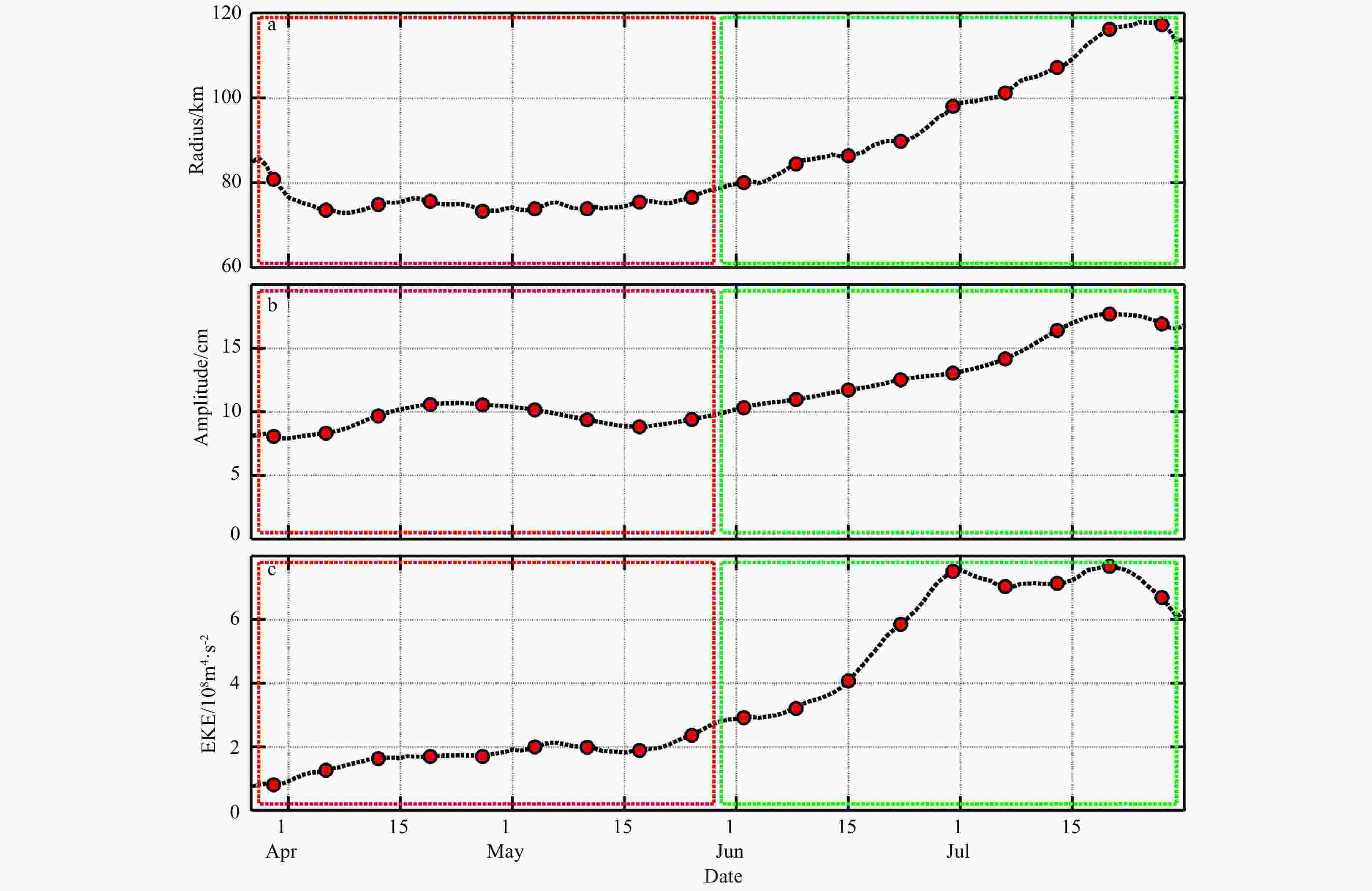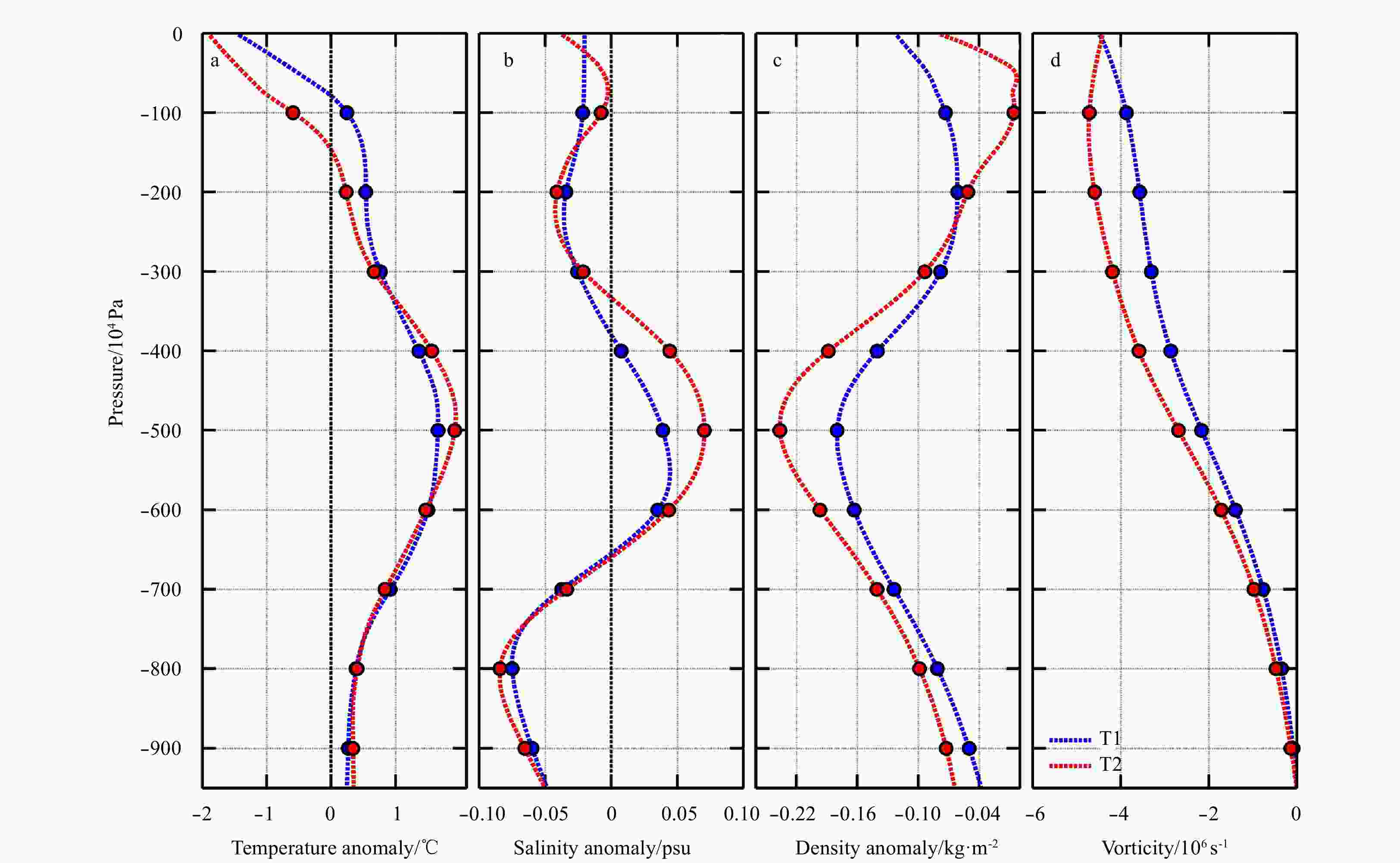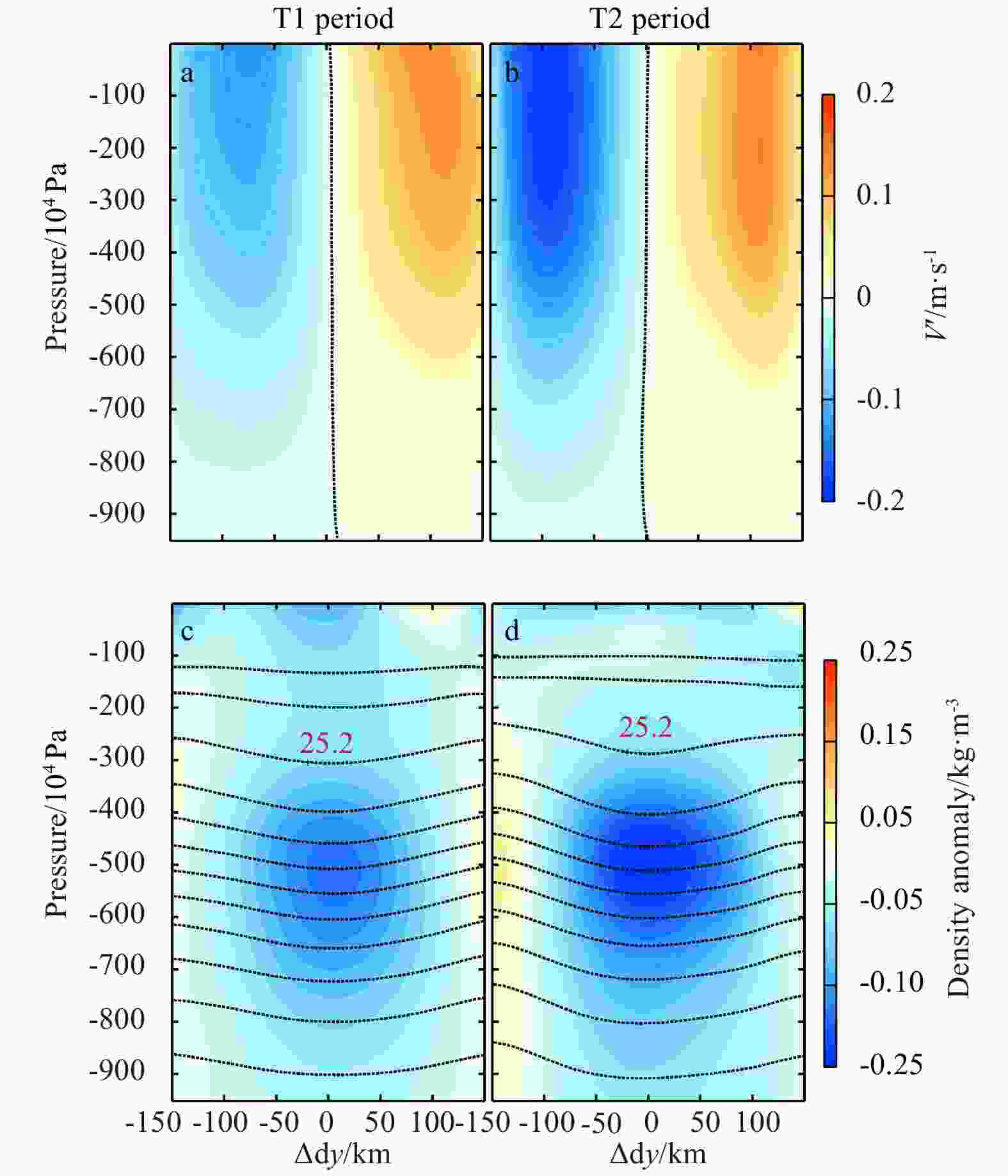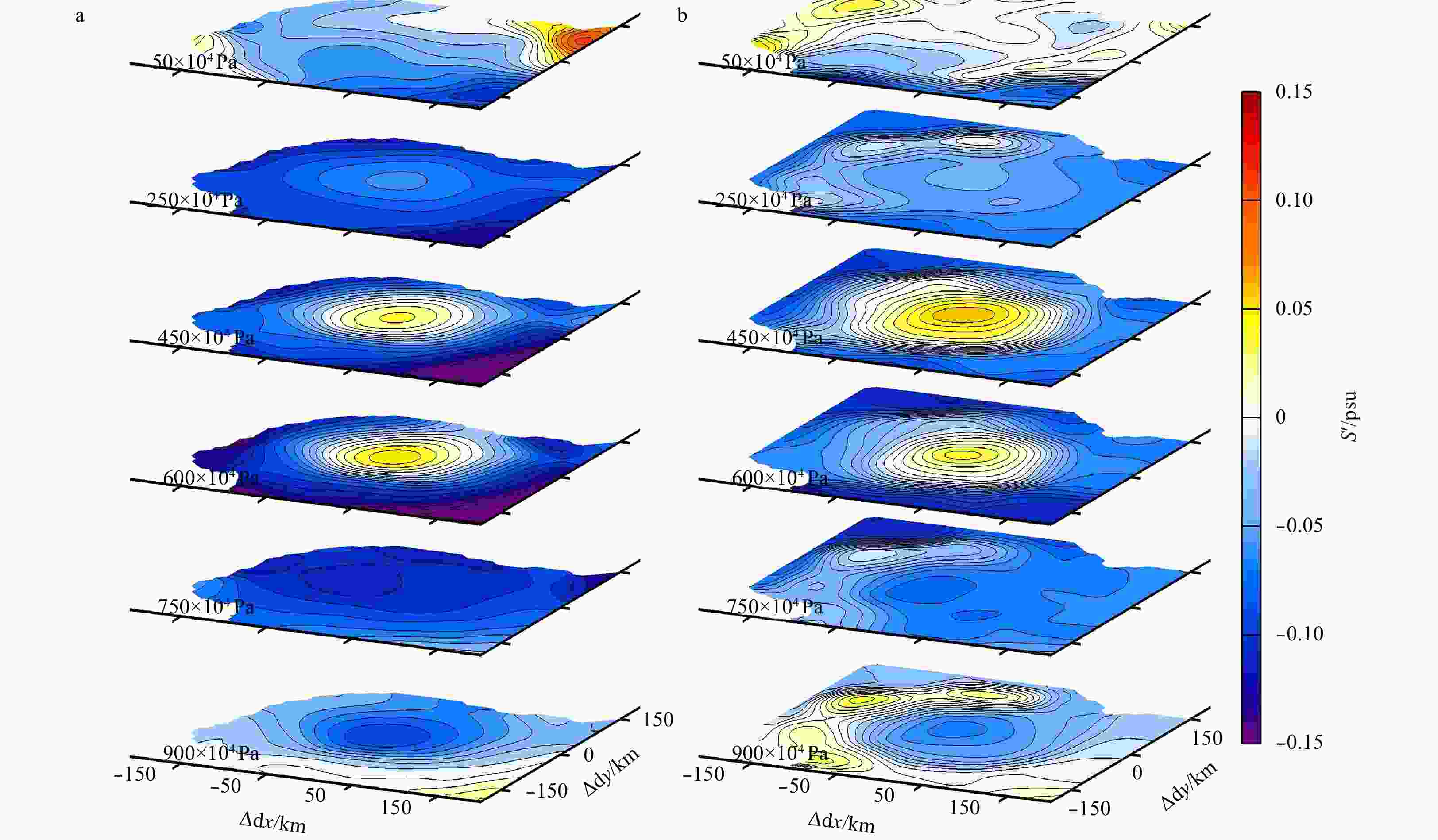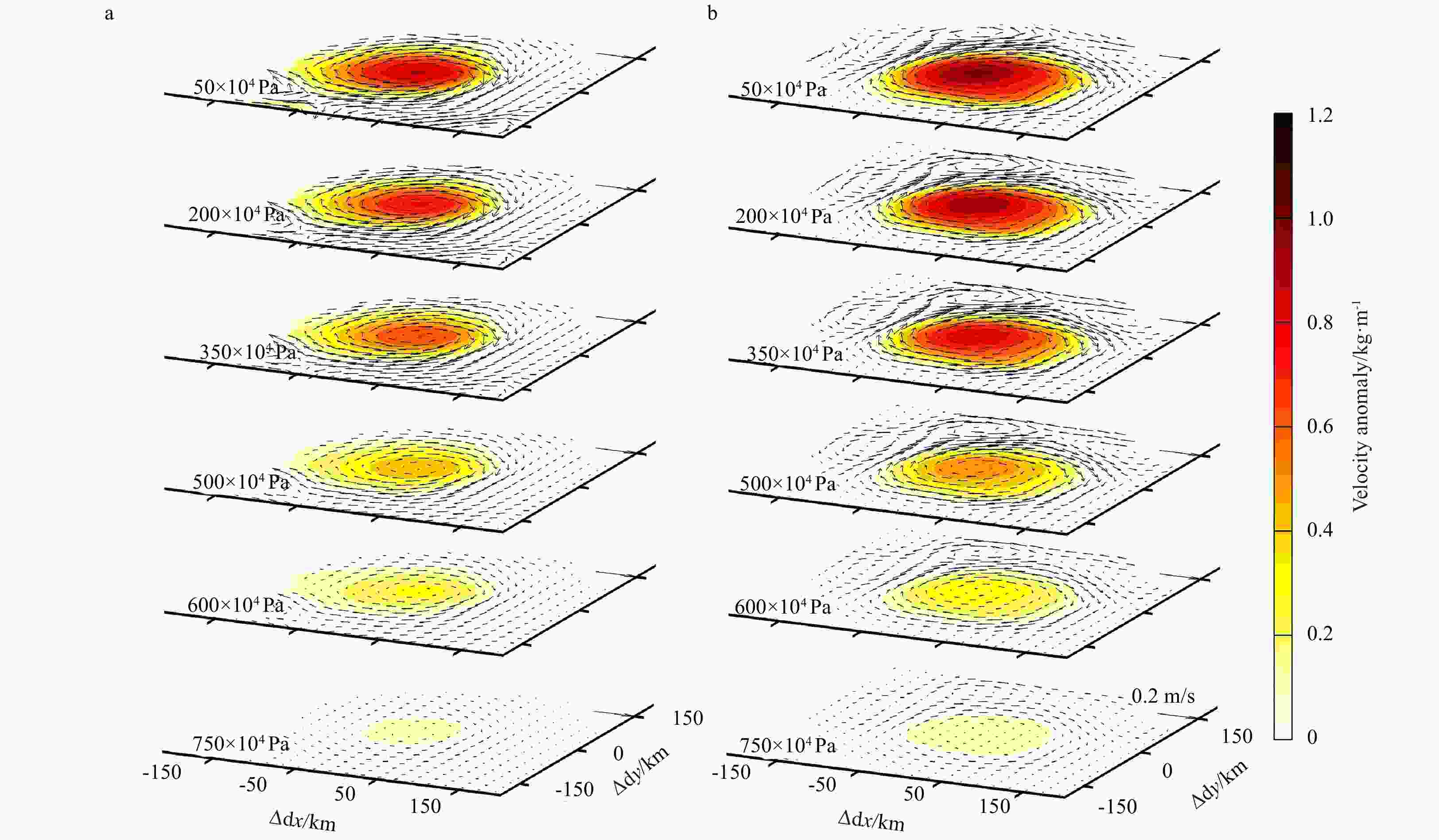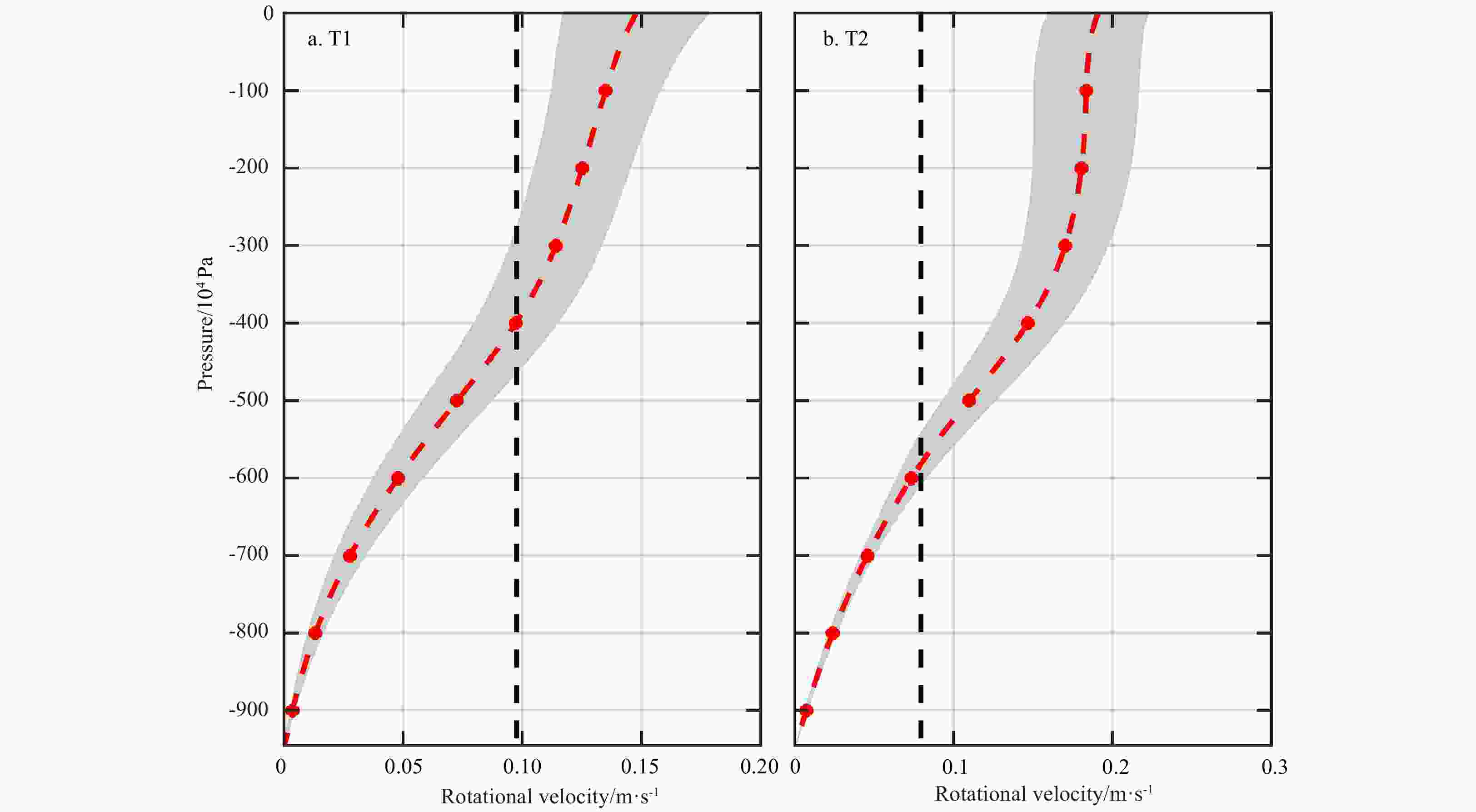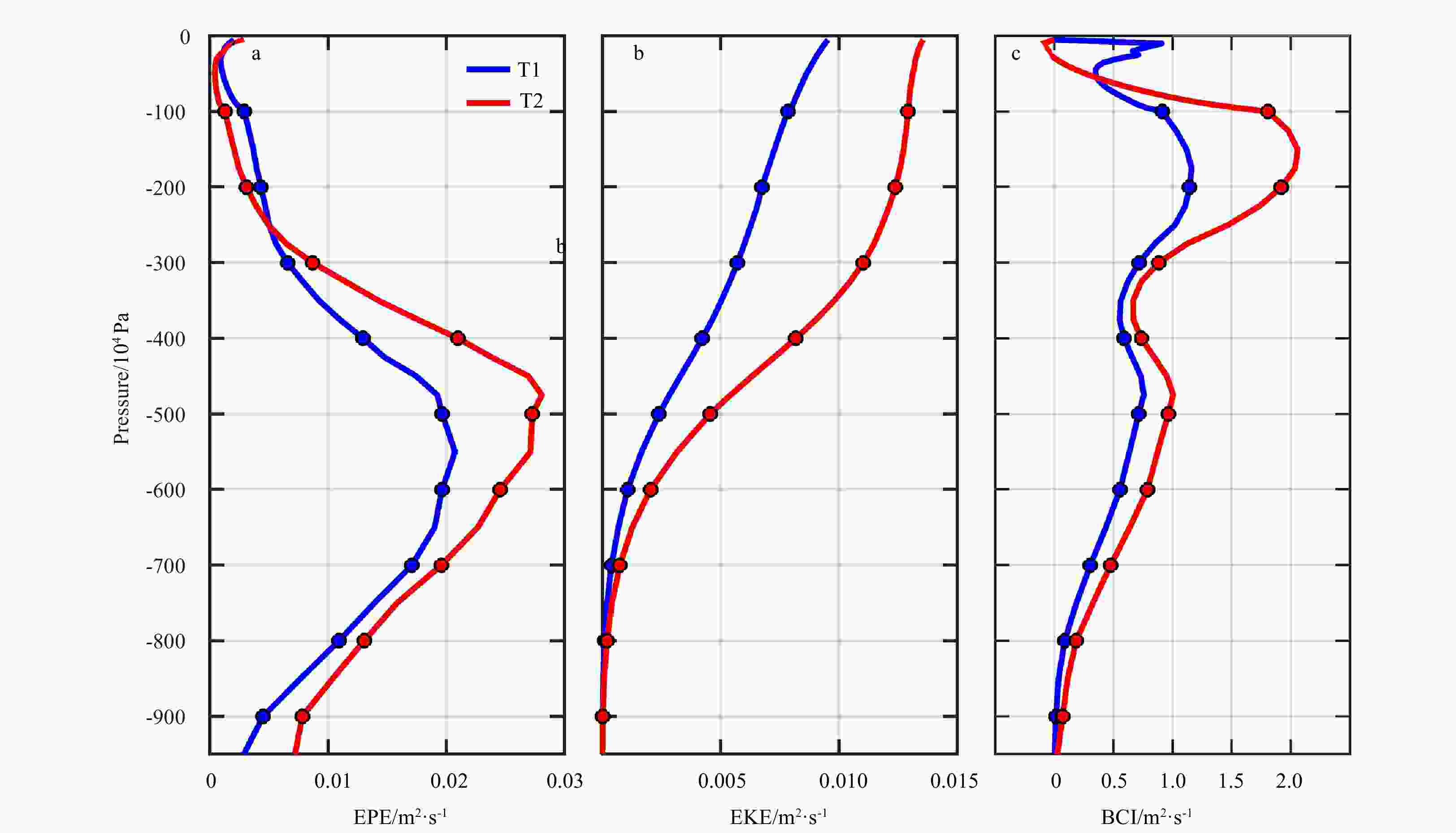Observation of an anti-cyclonic mesoscale eddy in the subtropical northwestern Pacific Ocean from altimetry and Argo profiling floats
-
Abstract: The comprehensive three-dimensional structures of an anti-cyclonic mesoscale eddy (AE) in the subtropical northwestern Pacific Ocean were investigated by combining the Argo floats profiles with enhanced vertical and temporal sampling and satellite altimetry data. The AE originated near the Kuroshio Extension and then propagated westward with mean velocity of 8.9 cm/s. Significant changes and evolutions during the AE’s growing stage (T1) and further growing stage (T2) were revealed through composite analysis. In the composite eddy core, maximum temperature (T) and salinity (S) anomalies were of 1.7 (1.9)°C and 0.04 (0.07) psu in T1 (T2) period, respectively. The composite T anomalies showed positive in almost whole depth, but the S anomalies exhibited a sandwich-like pattern. The eddy’s intensification and its influence on the intermediate ocean became more significant during its growth. The trapping depth increased from 400×104 Pa to 580×104 Pa while it was growing up, which means more water volume, heat and salt content in deeper layers can be transported. The AE was strongly nonlinear in upper oceans and can yield a typical mean volume transport of 0.17×106 m3/s and a mean heat and salt transport anomaly of 3.6×1011 W and –2.1×103 kg/s during the observation period. The Energy analysis showed that eddy potential and kinetic energy increased notably as it propagated westward and the baroclinic instability is the major energy source of the eddy growth. The variation of the remained Argo float trapped within the eddy indicated significant water advection during the eddy’s propagation.
-
Figure 1. Mean sea surface height (cm) of the northwestern Pacific Ocean from Rio et al. (2009) the contour interval is 10 cm and the blue rectangle indicates the regions where the anti-cyclonic eddy (AE) was observed (a), and the locations of the Argo floats (gray stars) deployed in the blue rectangle (b). The contours denote the altimeter sea level anomaly (SLA) field on that day. The contour interval of the SLA is 2 cm, and the negative, zero, and positive values are marked by the gray dashed, thick solid, thin solid lines, respectively. The green solid line denotes the trajectory of the AE and the purple dots’ interval is two weeks.
Figure 2. Evolutions of the AE detected by altimeter SLA from March 27 to July 25, 2014. The contours denote the altimeter SLA field on that day. The contour interval of the SLA is 3 cm, and the negative, zero, and positive values are marked by the gray dashed, thick solid, thin solid lines, respectively. The purple stars denote the locations of the Argo floats. The gray rectangle denotes the field of AE during T1 period; the red rectangle denotes the field of AE during T2 period.
Figure 7. Vertical sections of the zonal geostrophic current anomaly
$V'$ (m/s) of the composite AE at Δdx=0 during T1 (a) and T2 (b) period (The contour interval is 0.01 m/s and the dashed lines indicate the zero contours), and vertical sections of the density (black contours; in kg/m3) and density anomaly (color shading; in kg/m3) of the composite AE at Δdx=0 during T1 (c) and (d) period (The black contours’ interval is 0.2 kg/m3). -
[1] Chaigneau A, Gizolme A, Grados C. 2008. Mesoscale eddies off Peru in altimeter records: Identification algorithms and eddy spatio-temporal patterns. Progress in Oceanography, 79(2−4): 106–119. doi: 10.1016/j.pocean.2008.10.013 [2] Chaigneau A, Le Texier M, Eldin G, et al. 2011. Vertical structure of mesoscale eddies in the eastern South Pacific Ocean: a composite analysis from altimetry and Argo profiling floats. Journal of Geophysical Research, 116(C11): C11025. doi: 10.1029/2011JC007134 [3] Chelton D B, Gaube P, Schlax M G, et al. 2011a. The influence of nonlinear mesoscale eddies on near-surface oceanic chlorophyll. Science, 334(6054): 328–332. doi: 10.1126/science.1208897 [4] Chelton D B, Schlax M G, Samelson R M, et al. 2007. Global observations of large oceanic eddies. Geophysical Research Letters, 34(15): L15606. doi: 10.1029/2007GL030812 [5] Chelton D B, Schlax M G, Samelson R M. 2011b. Global observations of nonlinear mesoscale eddies. Progress in Oceanography, 91(2): 167–216. doi: 10.1016/j.pocean.2011.01.002 [6] Chen Gengxin, Gan Jianping, Xie Qiang, et al. 2012. Eddy heat and salt transports in the South China Sea and their seasonal modulations. Journal of Geophysical Research, 117(C5): C05021. doi: 10.1029/2011JC007724 [7] Chu Xiaoqing, Xue Huijie, Qi Yiquan, et al. 2014. An exceptional anticyclonic eddy in the South China Sea in 2010. Journal of Geophysical Research, 119(2): 881–897. doi: 10.1002/2013JC009314 [8] Early J J, Samelson R M, Chelton D B. 2011. The evolution and propagation of quasigeostrophic ocean Eddies. Journal of Physical Oceanography, 41(8): 1535–1555. doi: 10.1175/2011JPO4601.1 [9] Flierl G R. 1981. Particle motions in large-amplitude wave fields. Geophysical & Astrophysical Fluid Dynamics, 18(1−2): 39–74. doi: 10.1080/03091928108208773 [10] Hu Jianyu, Zheng Quanan, Sun Zhenyu, et al. 2012. Penetration of nonlinear Rossby eddies into South China Sea evidenced by cruise data. Journal of Geophysical Research, 117(C3): C03010. doi: 10.1029/2011JC007525 [11] Jing Zhao, Wu Lixin, Li Lei, et al. 2011. Turbulent diapycnal mixing in the subtropical northwestern Pacific: spatial-seasonal variations and role of eddies. Journal of Geophysical Research, 116(C10): C10028. doi: 10.1029/2011JC007142 [12] Li Yuanlong, Wang Fan. 2012. Spreading and salinity change of North Pacific Tropical Water in the Philippine Sea. Journal of Oceanography, 68(3): 439–452. doi: 10.1007/s10872-012-0110-3 [13] Li Yuanlong, Wang Fan, Sun Yan. 2012. Low-frequency spiciness variations in the tropical Pacific Ocean observed during 2003-2012. Geophysical Research Letters, 39(23): L23601. doi: 10.1029/2012GL053971 [14] Li Cheng, Zhang Zhiwei, Zhao Wei, et al. 2017. A statistical study on the subthermocline submesoscale eddies in the northwestern Pacific Ocean based on Argo data. Journal of Geophysical Research, 122(5): 3586–3598 [15] Liang Junhong, McWilliams J C, Kurian J, et al. 2012. Mesoscale variability in the northeastern tropical Pacific: Forcing mechanisms and eddy properties. Journal of Geophysical Research, 117(C7): C07003. doi: 10.1029/2012JC008008 [16] Liu Yu, Dong Changming, Guan Yuping, et al. 2012. Eddy analysis in the subtropical zonal band of the North Pacific Ocean. Deep Sea Research Part I: Oceanographic Research Papers, 68: 54–67. doi: 10.1016/j.dsr.2012.06.001 [17] Morrow R, Fang Fangxin, Fieux M, et al. 2003. Anatomy of three warm-core Leeuwin current eddies. Deep Sea Research Part II: Topical Studies in Oceanography, 50(12−13): 2229–2243. doi: 10.1016/S0967-0645(03)00054-7 [18] Noh Y, Yim B Y, You S H, et al. 2007. Seasonal variation of eddy kinetic energy of the North Pacific Subtropical Countercurrent simulated by an eddy-resolving OGCM. Geophysical Research Letters, 34(7): L07601. doi: 10.1029/2006GL029130 [19] Oey L Y. 2008. Loop current and deep eddies. Journal of Physical Oceanography, 38(7): 1426–1449. doi: 10.1175/2007JPO3818.1 [20] Okubo A. 1970. Horizontal dispersion of floatable particles in the vicinity of velocity singularities such as convergences. Deep Sea Research and Oceanographic Abstracts, 17(3): 445–454. doi: 10.1016/0011-7471(70)90059-8 [21] Qiu Bo. 1999. Seasonal eddy field modulation of the North Pacific Subtropical Countercurrent: TOPEX/Poseidon observations and theory. Journal of Physical Oceanography, 29(10): 2471–2486. doi: 10.1175/1520-0485(1999)029<2471:SEFMOT>2.0.CO;2 [22] Qiu Bo, Chen Shuiming. 2005. Eddy-induced heat transport in the subtropical North Pacific from Argo, TMI, and altimetry measurements. Journal of Physical Oceanography, 35(4): 458–473. doi: 10.1175/JPO2696.1 [23] Qiu Bo, Chen Shuiming. 2010. Interannual variability of the North Pacific Subtropical Countercurrent and its associated mesoscale eddy field. Journal of Physical Oceanography, 40(1): 213–225. doi: 10.1175/2009JPO4285.1 [24] Qiu Bo, Chen Shuiming. 2013. Concurrent decadal mesoscale eddy modulations in the western North Pacific subtropical gyre. Journal of Physical Oceanography, 43(2): 344–358. doi: 10.1175/JPO-D-12-0133.1 [25] Rio M H, Schaeffer P, Moreaux G, et al. 2009. A new mean dynamic topography computed over the global ocean from GRACE data, altimetry and in-situ measurements. In: OceanObs’09 Conference Proceedings. Venice: IOC/UNESCO and ESA, vol. 25. [26] Rio M H, Schaeffer P, Moreaux G, et al. 2009. A new mean dynamic topography computed over the global ocean from GRACE data, altimetry and in-situ measurements. In: OceanObs’09 Conference Proceedings. Venice: IOC/UNESCO and ESA, vol. 25. doi: 10.1175/1520-0485(1999)029<1488:ACOTCA>2.0.CO;2 [27] Roemmich D, Gilson J. 2001. Eddy transport of heat and thermocline waters in the North Pacific: a key to interannual/decadal climate variability?. Journal of Physical Oceanography, 31(3): 675–687. doi: 10.1175/1520-0485(2001)031<0675:ETOHAT>2.0.CO;2 [28] Roullet G, Capet X, Maze G. 2014. Global interior eddy available potential energy diagnosed from Argo floats. Geophysical Research Letters, 41(5): 1651–1656. doi: 10.1002/2013GL059004 [29] Rudnick D L, Jan S, Centurioni L, et al. 2011. Seasonal and mesoscale variability of the Kuroshio near its origin. Oceanography, 24(4): 52–63. doi: 10.5670/oceanog.2011.94 [30] Sasaki Y N, Schneider N, Maximenko N, et al. 2010. Observational evidence for propagation of decadal spiciness anomalies in the North Pacific. Geophysical Research Letters, 37(7): L07708. doi: 10.1029/2010GL042716 [31] Stammer D. 1997. Global characteristics of ocean variability estimated from regional TOPEX/Poseidon altimeter measurements. Journal of Physical Oceanography, 27(8): 1743–1769. doi: 10.1175/1520-0485(1997)027<1743:GCOOVE>2.0.CO;2 [32] Suga T, Kato A, Hanawa K. 2000. North Pacific Tropical Water: Its climatology and temporal changes associated with the climate regime shift in the 1970s. Progress in Oceanography, 47(2-4): 223–256. doi: 10.1016/S0079-6611(00)00037-9 [33] Sun Wenjin, Dong Changming, Wang Ruyun, et al. 2017. Vertical structure anomalies of oceanic eddies in the Kuroshio Extension region. Journal of Geophysical Research, 122(2): 1476–1496 [34] Talley L D. 1993. Distribution and formation of North Pacific intermediate water. Journal of Physical Oceanography, 23(3): 517–537. doi: 10.1175/1520-0485(1993)023<0517:DAFONP>2.0.CO;2 [35] Wang Jia, Ikeda M. 1997. Diagnosing ocean unstable baroclinic waves and meanders using the quasigeostrophic equations and Q-Vector method. Journal of Physical Oceanography, 27(6): 1158–1172. doi: 10.1175/1520-0485(1997)027<1158:DOUBWA>2.0.CO;2 [36] Wang Jia, Jin Meibing, Patrick E V, et al. 2001. Numerical simulations of the seasonal circulation patterns and thermohaline structures of Prince William Sound, Alaska. Fisheries Oceanography, 10(S1): 132–148 [37] Weiss J. 1991. The dynamics of enstrophy transfer in two-dimensional hydrodynamics. Physica D: Nonlinear Phenomena, 48(2–3): 273–294. doi: 10.1016/0167-2789(91)90088-Q [38] Wunsch C. 1999. Where do ocean eddy heat fluxes matter?. Journal of Geophysical Research, 104(C6): 13235–13249. doi: 10.1029/1999JC900062 [39] Xie Shangping. 2013. Advancing climate dynamics toward reliable regional climate projections. Journal of Ocean University of China, 12(2): 191–200. doi: 10.1007/s11802-013-2277-7 [40] Xiu Peng, Chai Fei, Xue Huijie, et al. 2012. Modeling the mesoscale eddy field in the Gulf of Alaska. Deep Sea Research Part I: Oceanographic Research Papers, 63: 102–117. doi: 10.1016/j.dsr.2012.01.006 [41] Xu Lixiao, Li Peiliang, Xie Shangping, et al. 2016. Observing mesoscale eddy effects on mode-water subduction and transport in the North Pacific. Nature Communications, 7(1): 10505. doi: 10.1038/ncomms10505 [42] Yang Guang, Wang Fan, Li Yuanlong, et al. 2013. Mesoscale eddies in the northwestern subtropical Pacific Ocean: statistical characteristics and three-dimensional structures. Journal of Geophysical Research, 118(4): 1906–1925. doi: 10.1002/jgrc.20164 [43] Yoshida S, Qiu Bo, Hacker P. 2011. Low-frequency eddy modulations in the Hawaiian Lee Countercurrent: observations and connection to the Pacific Decadal Oscillation. Journal of Geophysical Research, 116(C12): C12009. doi: 10.1029/2011JC007286 [44] Yuan Dongliang, Wang Zheng. 2011. Hysteresis and dynamics of a western boundary current flowing by a gap forced by impingement of mesoscale eddies. Journal of Physical Oceanography, 41(5): 878–888. doi: 10.1175/2010JPO4489.1 [45] Zhang Dongxiao, Lee T N, Johns W E, et al. 2001. The Kuroshio east of Taiwan: modes of variability and relationship to interior ocean mesoscale eddies. Journal of Physical Oceanography, 31(4): 1054–1074. doi: 10.1175/1520-0485(2001)031<1054:TKEOTM>2.0.CO;2 [46] Zhang Zhiwei, Li Peiliang, Xu Lixiao, et al. 2015. Subthermocline eddies observed by rapid‐sampling Argo floats in the subtropical northwestern Pacific Ocean in Spring 2014. Geophysical Research Letters, 42(15): 6438–6445. doi: 10.1002/2015GL064601 [47] Zhang Zhiwei, Liu Zhiyu, Richards K, et al. 2019. Elevated diapycnal mixing by a subthermocline eddy in the western equatorial Pacific. Geophysical Research Letters, 46(5): 2628–2636. doi: 10.1029/2018GL081512 [48] Zhang Zhiwei, Tian Jiwei, Qiu Bo, et al. 2016. Observed 3D structure, generation, and dissipation of oceanic mesoscale eddies in the South China Sea. Scientific Reports, 6(1): 24349. doi: 10.1038/srep24349 [49] Zhang Zhiwei, Zhao Wei, Tian Jiwei, et al. 2013. A mesoscale eddy pair southwest of Taiwan and its influence on deep circulation. Journal of Geophysical Research, 118(12): 6479–6494. doi: 10.1002/2013JC008994 [50] Zhang Ronghua, Rothstein L M, Busalacchi A J. 1998. Origin of upper-ocean warming and El Niño change on decadal scales in the tropical Pacific Ocean. Nature, 391(6670): 879–883. doi: 10.1038/36081 [51] Zhang Zhengguang, Wang Wei, Qiu Bo. 2014. Oceanic mass transport by mesoscale eddies. Science, 345(6194): 322–324. doi: 10.1126/science.1252418 [52] Zheng Quanan, Lin Hui, Meng Junmin, et al. 2008. Sub-mesoscale ocean vortex trains in the Luzon Strait. Journal of Geophysical Research, 113(C4): C04032. doi: 10.1029/2007JC004362 [53] Zheng Quanan, Tai Changkuo, Hu Jianyu, et al. 2011. Satellite altimeter observations of nonlinear Rossby eddy-Kuroshio interaction at the Luzon Strait. Journal of Oceanography, 67(4): 365–376. doi: 10.1007/s10872-011-0035-2 -





 下载:
下载:

